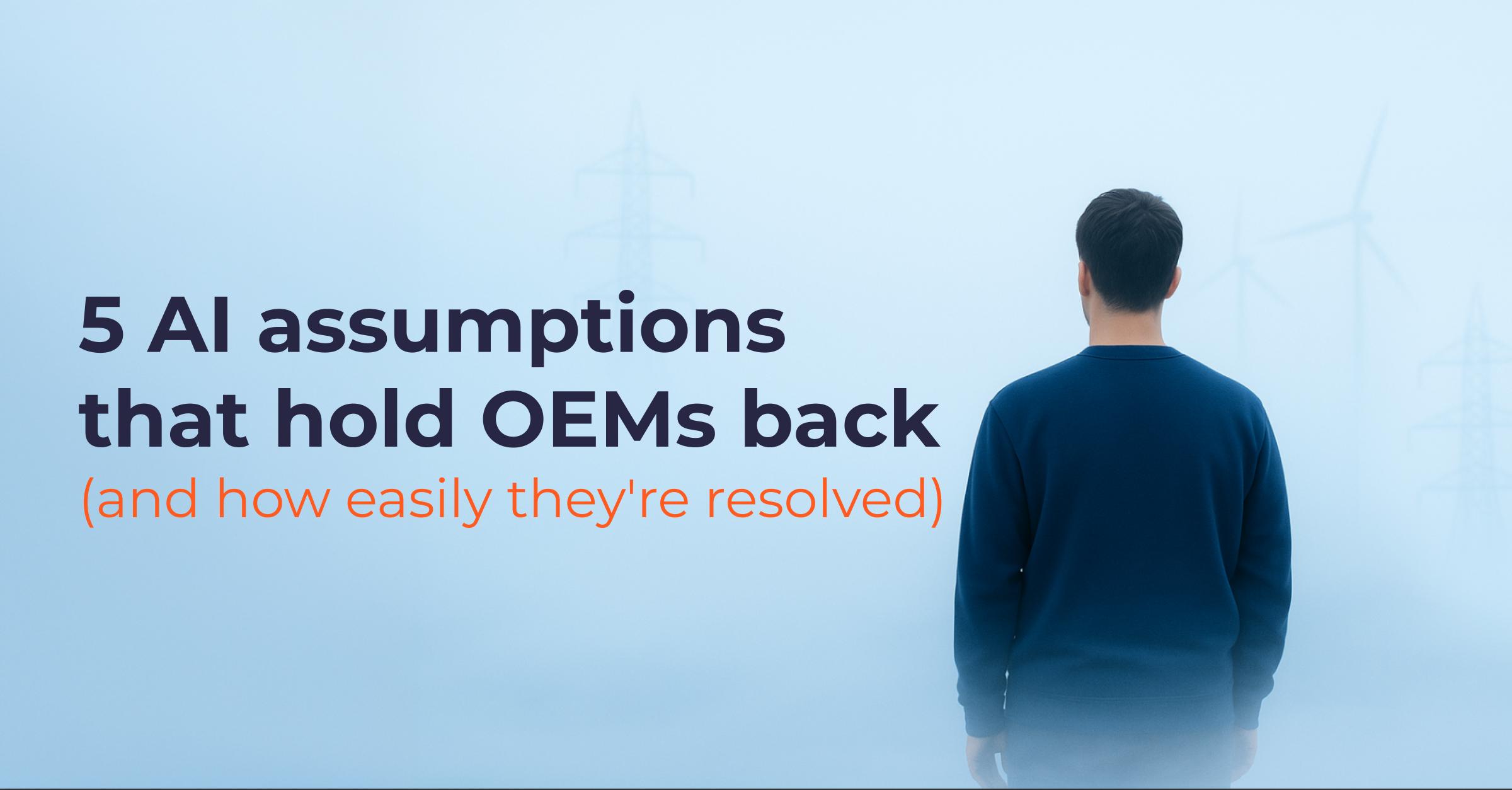Five AI assumptions that hold OEMs back (and how easily they're resolved)
After conversations with energy sector OEMs about AI implementation, we've identified five recurring assumptions that consistently prevent companies from moving forward with artificial intelligence initiatives.

These aren't unreasonable concerns, they're logical questions that any responsible business leader would ask. The challenge is that these assumptions, while understandable, are often based on outdated information or misconceptions about how modern AI implementation actually works.
Assumption #1: "We need perfect documentation first"
"We don't have enough documentation yet." "Our knowledge base isn't strong enough."
"We need to organize our data first."
This is the most common reason OEMs postpone AI implementation. They believe they need comprehensive, perfectly organized documentation before AI can be useful.
The reality: These assumptions, while completely understandable, don't reflect how modern AI implementation actually works.
The fix: Start with what you have. Modern AI platforms can process incomplete documentation and identify gaps as they emerge. The insights gained from working with imperfect data often reveal exactly which documentation needs attention first.
Assumption #2: "AI requires big, binding commitments"
"We're not ready for a big AI contract." "This feels too permanent for where we are." "What if it doesn't work for our specific needs?"
Many OEMs avoid AI implementation because they assume it requires significant upfront commitments, complex contracts, or permanent changes to their operations.
The reality: The best AI implementations start small and prove value before scaling. There's no need for massive commitments or irreversible decisions.
The fix: Look for programs that let you test AI's potential without long-term obligations. Chapter AI's 4-month Bootcamp, for example, provides hands-on pilots, custom AI playbooks, and clear roadmaps, with no binding commitments. You explore AI's potential on your terms, then decide how to proceed.
Assumption #3: "We should build AI internally"
"Our IT team can handle this internally." "We want full control over the AI system." "External platforms won't understand our specific needs."
The instinct to build AI capabilities internally seems logical—maintain control, customize everything, avoid vendor dependence. But building AI systems requires specialized expertise that most OEMs lack.
The reality: Building AI systems is like building your own CRM or accounting software. Technically possible, but rarely the best use of resources. Modern AI platforms designed for specific industries offer more functionality and reliability than most internal teams can develop.
The fix: Focus your technical resources on what differentiates your business, your products and core systems. Use specialized AI platforms for AI capabilities, just as you use specialized software for other business functions.
Assumption #4: "We have too many other priorities"
"We have a major IT migration happening." "The head of customer support is leaving." "Other projects have higher priority right now."
This might be the most frustrating mistake because it's self-perpetuating. OEMs postpone AI implementation due to current operational pressures, the same pressures that AI could help resolve.
The reality: There will always be competing priorities. The question is whether AI can help address some of those priorities rather than adding to them.
The fix: Reframe AI as a solution to existing problems, not an additional project. If your support team is overwhelmed, AI can reduce their workload. If you're entering new markets, AI can scale your support capabilities. Position AI as operational relief, not operational burden.
Assumption #5: "External AI can't meet our security standards"
"Our IT security requirements are too strict." "External AI platforms can't meet our compliance standards." "Integration with our systems will be too complex."
Energy sector OEMs rightfully have stringent security and compliance requirements. The mistake is assuming that external AI platforms can't meet these standards or that integration requires major system changes.
The reality: Modern AI platforms designed for the energy sector are built with these requirements in mind. They offer enterprise-grade security, compliance certifications, and architectures that work alongside existing systems without requiring integration.
The fix: Evaluate AI platforms based on their actual security credentials and implementation approach, not assumptions. Look for platforms that operate independently of your critical systems while still providing the functionality you need.
Why these assumptions persist
These five assumptions share a common source: they're based on early AI implementations that were indeed complex, risky, and resource-intensive. But the AI landscape has matured significantly. Modern AI platforms, especially those designed for specific industries like energy, operate very differently from the experimental systems that created these assumptions.
A better approach to AI implementation
Instead of waiting for ideal conditions or committing to major changes, consider a bootcamp approach:
- Start with pilot projects using your existing documentation
- Test AI's potential without long-term commitments
- Build internal expertise through hands-on experience
- Develop a custom roadmap based on actual results, not theoretical benefits
This approach addresses all five mistakes simultaneously. You're not waiting for perfect conditions, not making binding commitments, not building from scratch, not adding to competing priorities, and not assuming complex integrations.
The cost of waiting
While these mistakes seem cautious and prudent, they carry hidden costs. Every month of delay means:
- Support teams continue spending 12 minutes per query on information retrieval
- Customer satisfaction remains constrained by response times
- Competitors who act faster build operational advantages
- Seasonal support surges continue to overwhelm teams
The biggest risk isn't implementing AI imperfectly—it's not implementing it at all while operational pressures compound.
Moving forward
If you recognize your organization in any of these mistakes, you're not alone. Most energy sector OEMs encounter these same challenges when considering AI implementation. The key is shifting perspective from "Are we ready for AI?" to "How can AI help us with current challenges?" This reframing transforms AI from an additional burden into operational relief.
Ready to explore AI without the typical commitments and complexity?
Our AI-Readiness Bootcamp is a 4-month program designed specifically for energy sector OEMs. No binding contracts, no major system changes, just hands-on pilots and clear roadmaps to help you understand AI's potential for your specific situation.
Learn more about taking the first step without the typical risks: https://www.chapter.works/summer-bootcamp-2025
Discover Chapter yourself
Samen maken we een duurzame energietransitie mogelijk.






